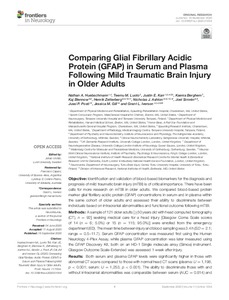Comparing Glial Fibrillary Acidic Protein (GFAP) in Serum and Plasma Following Mild Traumatic Brain Injury in Older Adults
Nicholas J. Ashton; Joel Simrén; Henrik Zetterberg; Ksenia Berghem; Justin E. Karr; Jussi P. Posti; Jessica M. Gill; Teemu M. Luoto; Nathan A. Huebschmann; Grant L. Iverson; Kaj Blennow
Comparing Glial Fibrillary Acidic Protein (GFAP) in Serum and Plasma Following Mild Traumatic Brain Injury in Older Adults
Nicholas J. Ashton
Joel Simrén
Henrik Zetterberg
Ksenia Berghem
Justin E. Karr
Jussi P. Posti
Jessica M. Gill
Teemu M. Luoto
Nathan A. Huebschmann
Grant L. Iverson
Kaj Blennow
FRONTIERS MEDIA SA
Julkaisun pysyvä osoite on:
https://urn.fi/URN:NBN:fi-fe2021042827221
https://urn.fi/URN:NBN:fi-fe2021042827221
Tiivistelmä
Objective:Identification and validation of blood-based biomarkers for the diagnosis and prognosis of mild traumatic brain injury (mTBI) is of critical importance. There have been calls for more research on mTBI in older adults. We compared blood-based protein marker glial fibrillary acidic protein (GFAP) concentrations in serum and in plasma within the same cohort of older adults and assessed their ability to discriminate between individuals based on intracranial abnormalities and functional outcome following mTBI. Methods:A sample of 121 older adults [>= 50 years old with head computed tomography (CT),n= 92] seeking medical care for a head injury [Glasgow Coma Scale scores of 14 (n= 6; 5.0%) or 15 (n= 115; 95.0%)] were enrolled from the emergency department (ED). The mean time between injury and blood sampling was 3.4 h (SD= 2.1; range = 0.5-11.7). Serum GFAP concentration was measured first using the Human Neurology 4-Plex Assay, while plasma GFAP concentration was later measured using the GFAP Discovery Kit, both on an HD-1 Single molecule array (Simoa) instrument. Glasgow Outcome Scale-Extended was assessed 1 week after injury. Results:Both serum and plasma GFAP levels were significantly higher in those with abnormal CT scans compared to those with normal head CT scans (plasma:U= 1,198,p< 0.001; serum:U= 1,253,p< 0.001). The ability to discriminate those with and without intracranial abnormalities was comparable between serum (AUC = 0.814) and plasma (AUC = 0.778). In the total sample, GFAP concentrations were considerably higher in plasma than in serum (Wilcoxon signed-rank testz= 0.42,p< 0.001,r= 0.42). Serum and plasma GFAP levels were highly correlated in the total sample and within all subgroups (Spearman'srhorange: 0.826-0.907). Both serum and plasma GFAP levels were significantly higher in those with poor compared to good functional outcome (serum:U= 1,625,p= 0.002; plasma:U= 1,539,p= 0.013). Neither plasma (AUC = 0.653) nor serum (AUC = 0.690) GFAP were adequate predictors of functional outcome 1 week after injury. Conclusions:Despite differences in concentration, serum and plasma GFAP levels were highly correlated and had similar discriminability between those with and without intracranial abnormalities on head CT following an mTBI. Neither serum nor plasma GFAP had adequate discriminability to identify patients who would have poor functional outcome.
Kokoelmat
- Rinnakkaistallenteet [19207]
